An Investigation of Culinary Authenticity and Tourism in Bangkok
VerifiedAdded on 2020/11/10
|17
|2163
|158
Report
AI Summary
This report investigates the relationship between culinary authenticity, tourism growth, and destination image, specifically focusing on the regional and local eatery culture in Bangkok. The research aims to understand how local food contributes to tourism, promotes the destination's image, and identifies challenges for future growth. The study reviews existing literature, including the Gastronomy Identity Model and frameworks linking food and tourism, and explores different styles of culinary tourism. The methodology involves both qualitative and quantitative approaches, including sampling techniques like purposive, quota, and snowball sampling, and data collection through interviews with tourists, restaurant owners, and local people. The report also acknowledges limitations, such as time constraints and potential biases in sampling, and provides a comprehensive list of references.
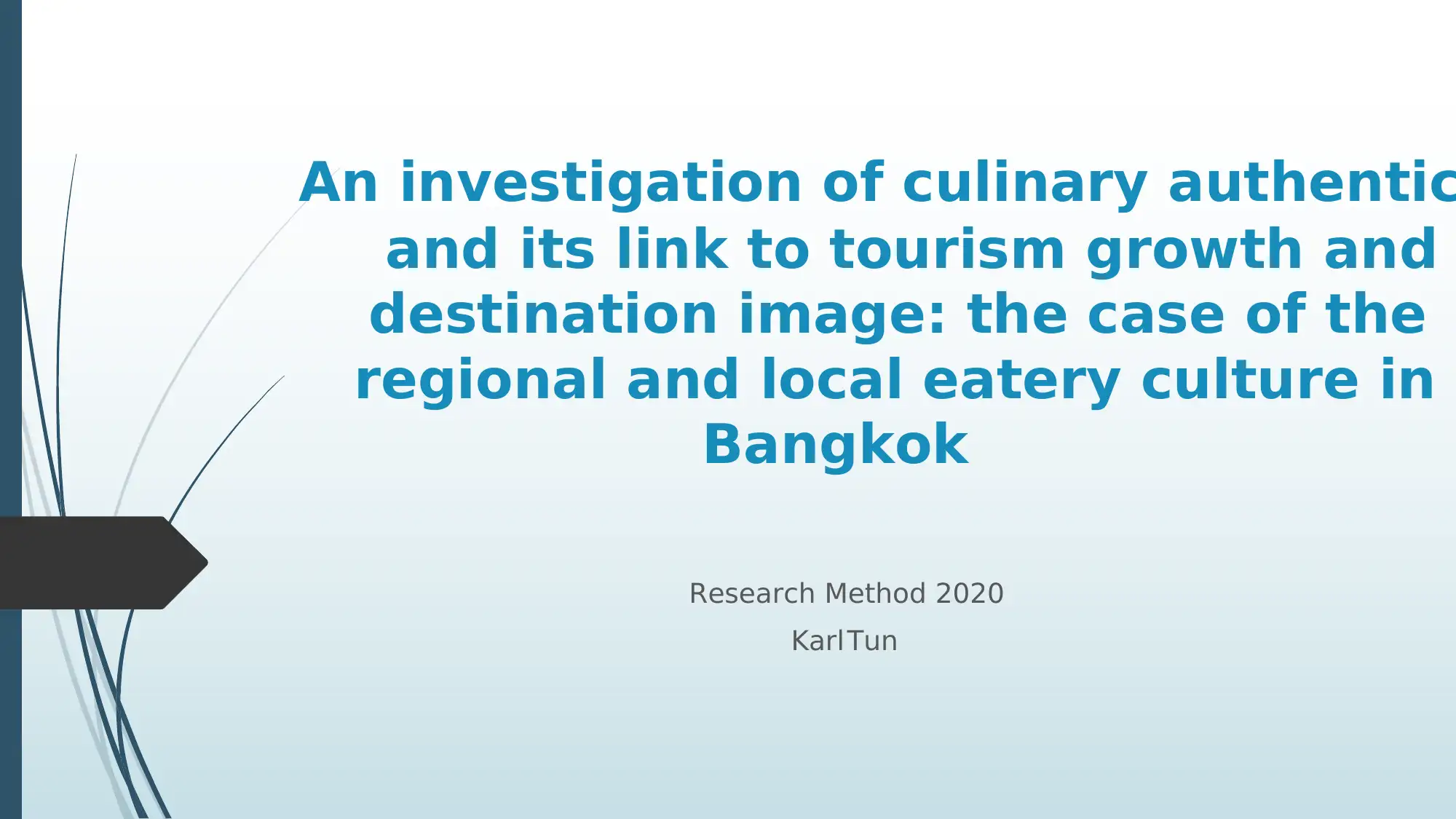
An investigation of culinary authentic
and its link to tourism growth and
destination image: the case of the
regional and local eatery culture in
Bangkok
Research Method 2020
KarlTun
and its link to tourism growth and
destination image: the case of the
regional and local eatery culture in
Bangkok
Research Method 2020
KarlTun
Paraphrase This Document
Need a fresh take? Get an instant paraphrase of this document with our AI Paraphraser

Table of Contents
´ Introduction 3
´ Aim & Objective 4
´ Literature Review 5
´ Gastronomy Identity Model 6
´ Framework for linking food and tourism 10
´ Methodology 12
´ Sampling 13
´ Data Collection 14
´ Limitation 15
´ References 16-18
06/11/2020Research Method 2020 Karl Tun
2
´ Introduction 3
´ Aim & Objective 4
´ Literature Review 5
´ Gastronomy Identity Model 6
´ Framework for linking food and tourism 10
´ Methodology 12
´ Sampling 13
´ Data Collection 14
´ Limitation 15
´ References 16-18
06/11/2020Research Method 2020 Karl Tun
2

Introduction
´ The food industry is one of the physical needs of tourism and the food and
beverage sectors in today's world. (Santich, 2007).
´ Food is an essential part of travel.
´ Most tourists also taste food from other cultures, whether they are engaged
or not.
´ In order to examine how gastronomic tourism has been affected in
Bangkok, the authors carries out this research to investigate the increase in
the local tourism consumption of local food in the regions.
´ This study will contribute to an improvement of better understanding of how
Gastronomy Identity Model applied to the case.
06/11/2020Research Method 2020 Karl Tun
3
´ The food industry is one of the physical needs of tourism and the food and
beverage sectors in today's world. (Santich, 2007).
´ Food is an essential part of travel.
´ Most tourists also taste food from other cultures, whether they are engaged
or not.
´ In order to examine how gastronomic tourism has been affected in
Bangkok, the authors carries out this research to investigate the increase in
the local tourism consumption of local food in the regions.
´ This study will contribute to an improvement of better understanding of how
Gastronomy Identity Model applied to the case.
06/11/2020Research Method 2020 Karl Tun
3
⊘ This is a preview!⊘
Do you want full access?
Subscribe today to unlock all pages.

Trusted by 1+ million students worldwide
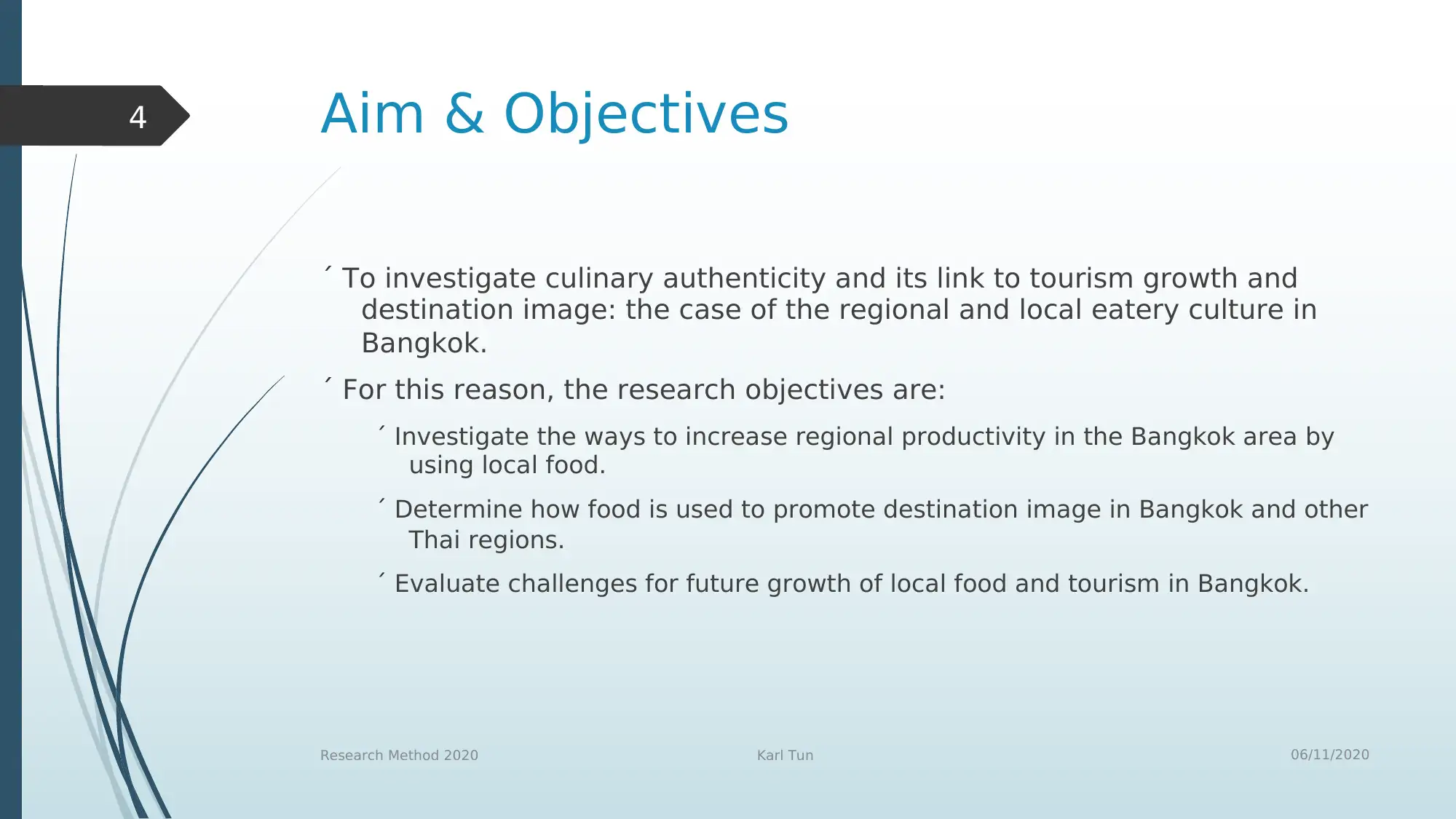
Aim & Objectives
´ To investigate culinary authenticity and its link to tourism growth and
destination image: the case of the regional and local eatery culture in
Bangkok.
´ For this reason, the research objectives are:
´ Investigate the ways to increase regional productivity in the Bangkok area by
using local food.
´ Determine how food is used to promote destination image in Bangkok and other
Thai regions.
´ Evaluate challenges for future growth of local food and tourism in Bangkok.
06/11/2020Research Method 2020 Karl Tun
4
´ To investigate culinary authenticity and its link to tourism growth and
destination image: the case of the regional and local eatery culture in
Bangkok.
´ For this reason, the research objectives are:
´ Investigate the ways to increase regional productivity in the Bangkok area by
using local food.
´ Determine how food is used to promote destination image in Bangkok and other
Thai regions.
´ Evaluate challenges for future growth of local food and tourism in Bangkok.
06/11/2020Research Method 2020 Karl Tun
4
Paraphrase This Document
Need a fresh take? Get an instant paraphrase of this document with our AI Paraphraser
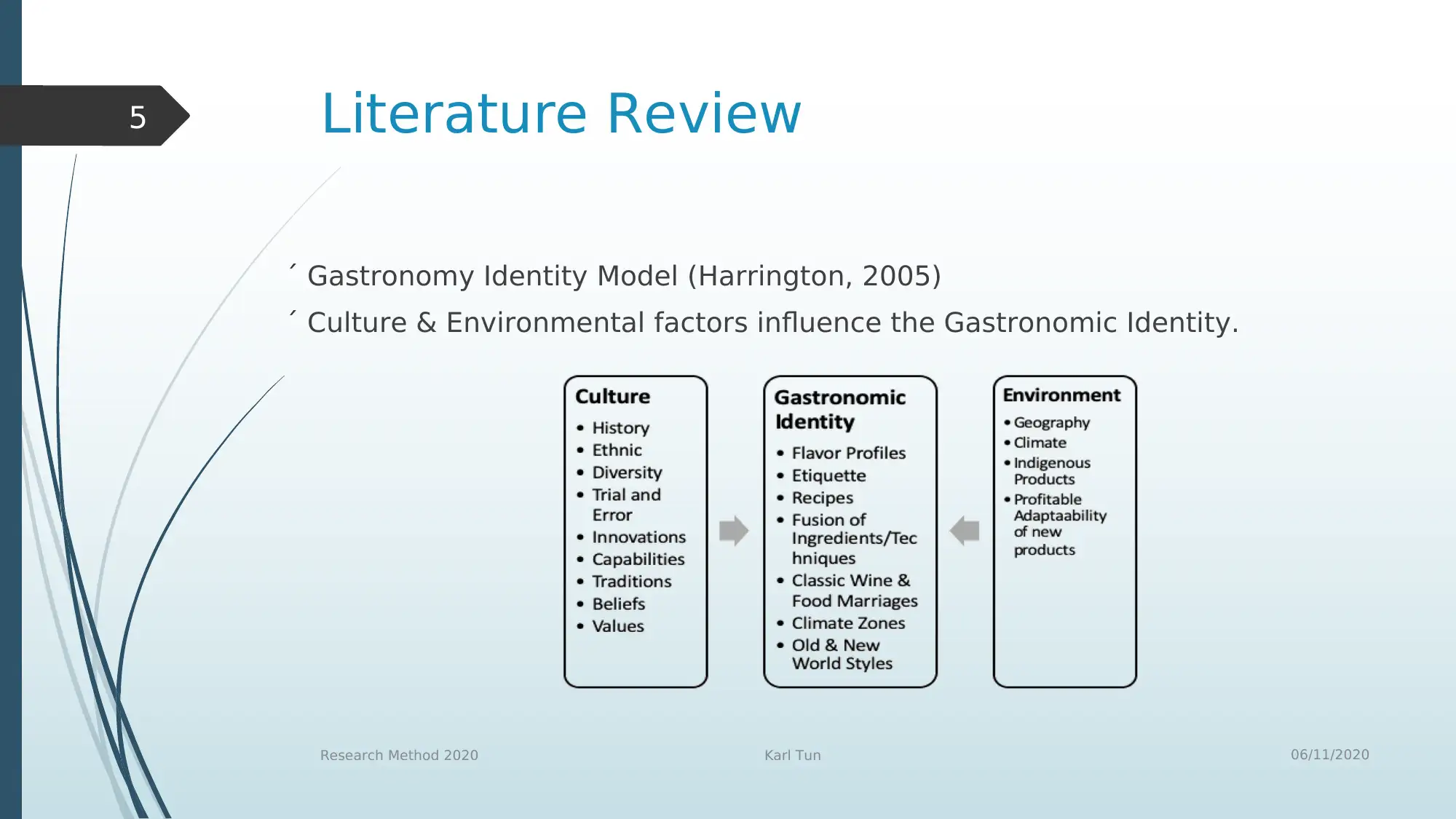
Literature Review
´ Gastronomy Identity Model (Harrington, 2005)
´ Culture & Environmental factors influence the Gastronomic Identity.
06/11/2020Research Method 2020 Karl Tun
5
´ Gastronomy Identity Model (Harrington, 2005)
´ Culture & Environmental factors influence the Gastronomic Identity.
06/11/2020Research Method 2020 Karl Tun
5
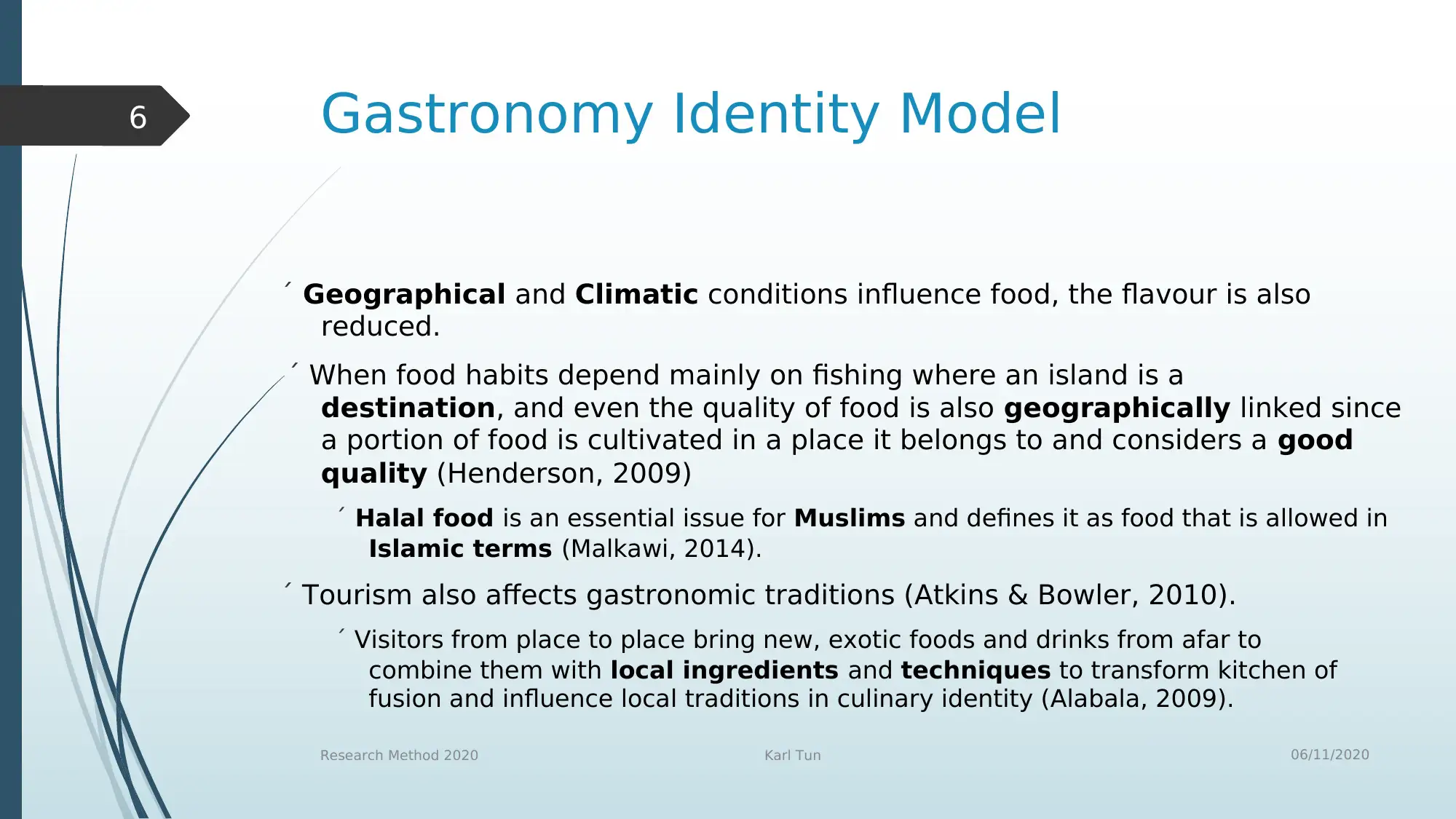
Gastronomy Identity Model
´ Geographical and Climatic conditions influence food, the flavour is also
reduced.
´ When food habits depend mainly on fishing where an island is a
destination, and even the quality of food is also geographically linked since
a portion of food is cultivated in a place it belongs to and considers a good
quality (Henderson, 2009)
´ Halal food is an essential issue for Muslims and defines it as food that is allowed in
Islamic terms (Malkawi, 2014).
´ Tourism also affects gastronomic traditions (Atkins & Bowler, 2010).
´ Visitors from place to place bring new, exotic foods and drinks from afar to
combine them with local ingredients and techniques to transform kitchen of
fusion and influence local traditions in culinary identity (Alabala, 2009).
06/11/2020Research Method 2020 Karl Tun
6
´ Geographical and Climatic conditions influence food, the flavour is also
reduced.
´ When food habits depend mainly on fishing where an island is a
destination, and even the quality of food is also geographically linked since
a portion of food is cultivated in a place it belongs to and considers a good
quality (Henderson, 2009)
´ Halal food is an essential issue for Muslims and defines it as food that is allowed in
Islamic terms (Malkawi, 2014).
´ Tourism also affects gastronomic traditions (Atkins & Bowler, 2010).
´ Visitors from place to place bring new, exotic foods and drinks from afar to
combine them with local ingredients and techniques to transform kitchen of
fusion and influence local traditions in culinary identity (Alabala, 2009).
06/11/2020Research Method 2020 Karl Tun
6
⊘ This is a preview!⊘
Do you want full access?
Subscribe today to unlock all pages.

Trusted by 1+ million students worldwide

Styles of Tourism
´ Four styles of culinary Tourism (Boyne et al, 2003)
´ Style I - Tourists are the ones where gastronomy is important during their holidays
and they look for the more local food items
´ Style II - Gastronomy is also important for tourists of Style II, but not for tourists of
Style I. When presented to them, they admire cuisine aspects
´ Style III - For Style III tourists the cuisine is not an important part of their vacation,
but during their holiday they may participate in culinary events.
´ Style IV - Style IV tourists during their holidays are not interested in food products
´ The result is that people would like to try new foods, but would also like to avoid
disgusting tastes (Gyimothy & Mykletun, 2008).
06/11/2020Research Method 2020 Karl Tun
7
´ Four styles of culinary Tourism (Boyne et al, 2003)
´ Style I - Tourists are the ones where gastronomy is important during their holidays
and they look for the more local food items
´ Style II - Gastronomy is also important for tourists of Style II, but not for tourists of
Style I. When presented to them, they admire cuisine aspects
´ Style III - For Style III tourists the cuisine is not an important part of their vacation,
but during their holiday they may participate in culinary events.
´ Style IV - Style IV tourists during their holidays are not interested in food products
´ The result is that people would like to try new foods, but would also like to avoid
disgusting tastes (Gyimothy & Mykletun, 2008).
06/11/2020Research Method 2020 Karl Tun
7
Paraphrase This Document
Need a fresh take? Get an instant paraphrase of this document with our AI Paraphraser
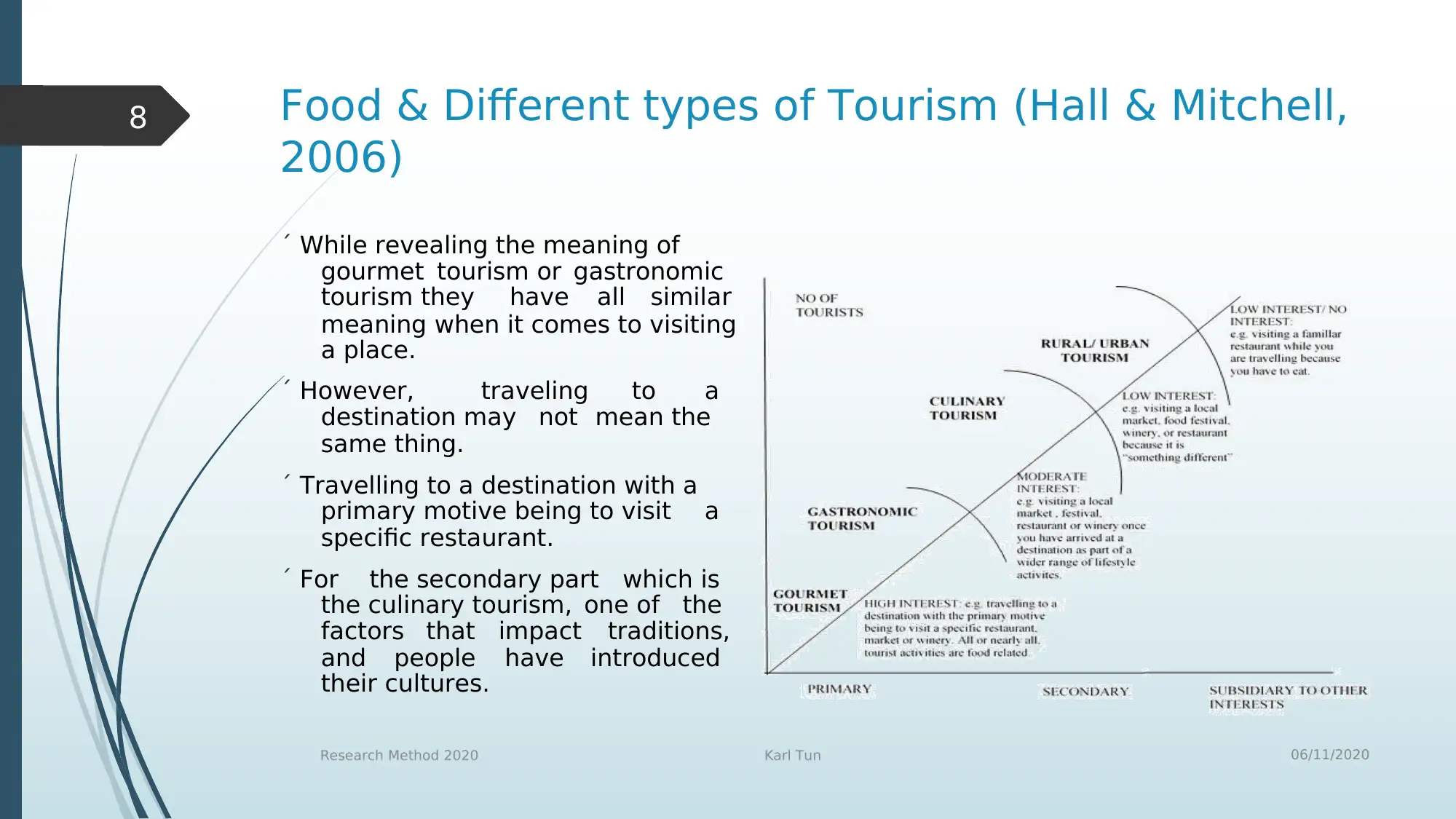
Food & Different types of Tourism (Hall & Mitchell,
2006)
´ While revealing the meaning of
gourmet tourism or gastronomic
tourism they have all similar
meaning when it comes to visiting
a place.
´ However, traveling to a
destination may not mean the
same thing.
´ Travelling to a destination with a
primary motive being to visit a
specific restaurant.
´ For the secondary part which is
the culinary tourism, one of the
factors that impact traditions,
and people have introduced
their cultures.
06/11/2020Research Method 2020 Karl Tun
8
2006)
´ While revealing the meaning of
gourmet tourism or gastronomic
tourism they have all similar
meaning when it comes to visiting
a place.
´ However, traveling to a
destination may not mean the
same thing.
´ Travelling to a destination with a
primary motive being to visit a
specific restaurant.
´ For the secondary part which is
the culinary tourism, one of the
factors that impact traditions,
and people have introduced
their cultures.
06/11/2020Research Method 2020 Karl Tun
8
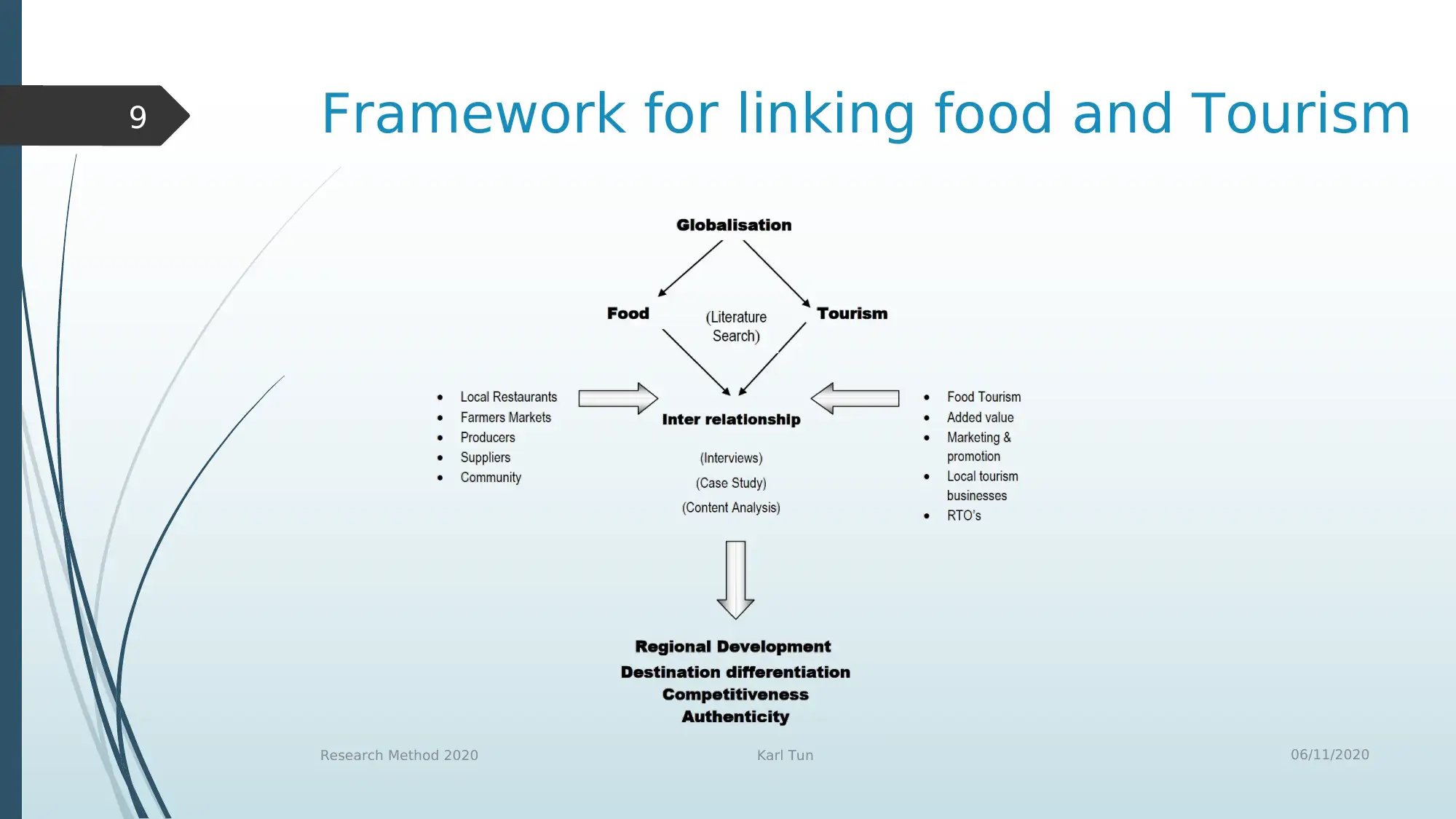
Framework for linking food and Tourism
06/11/2020Research Method 2020 Karl Tun
9
06/11/2020Research Method 2020 Karl Tun
9
⊘ This is a preview!⊘
Do you want full access?
Subscribe today to unlock all pages.

Trusted by 1+ million students worldwide
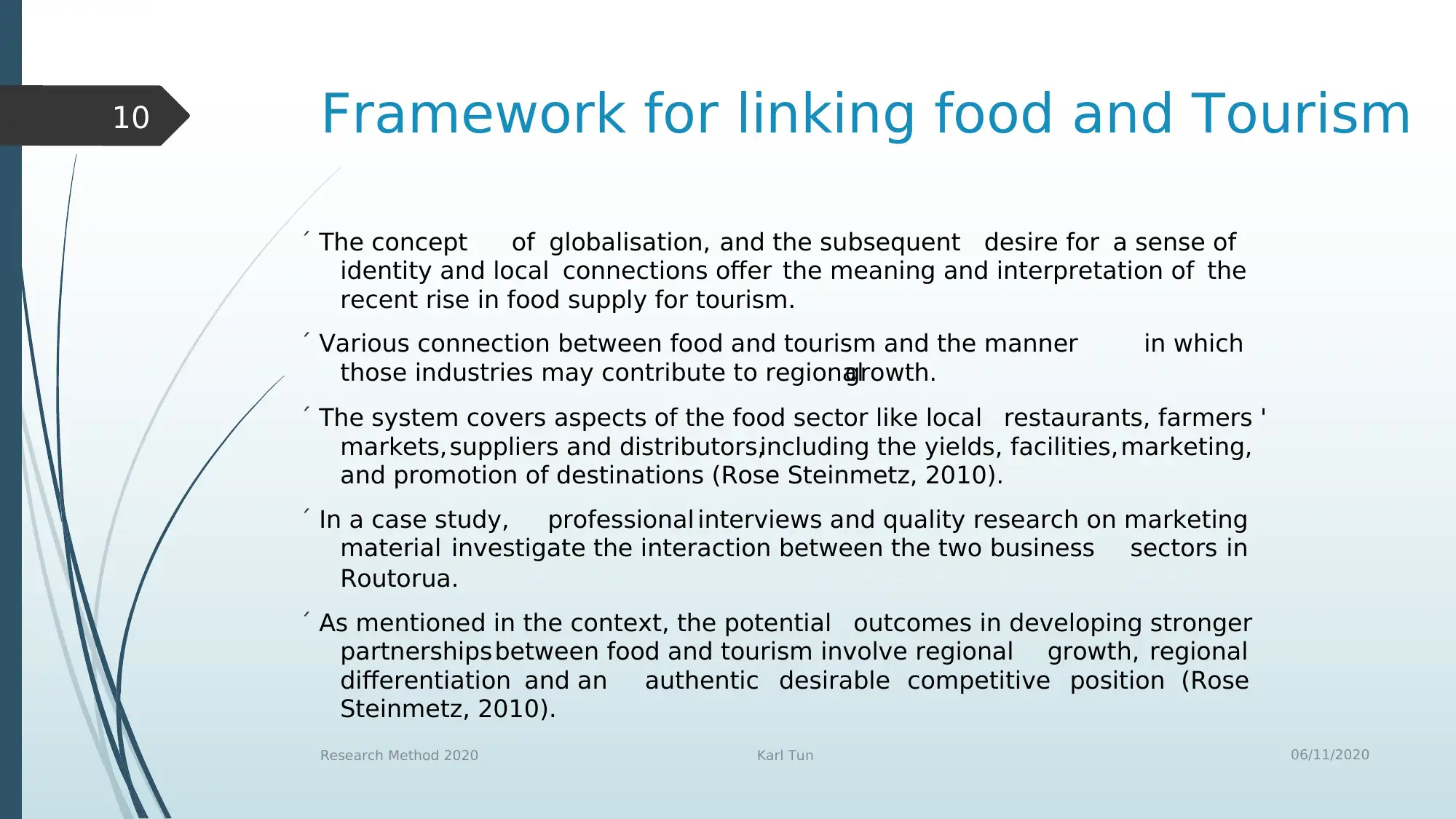
Framework for linking food and Tourism
´ The concept of globalisation, and the subsequent desire for a sense of
identity and local connections offer the meaning and interpretation of the
recent rise in food supply for tourism.
´ Various connection between food and tourism and the manner in which
those industries may contribute to regionalgrowth.
´ The system covers aspects of the food sector like local restaurants, farmers '
markets,suppliers and distributors,including the yields, facilities,marketing,
and promotion of destinations (Rose Steinmetz, 2010).
´ In a case study, professional interviews and quality research on marketing
material investigate the interaction between the two business sectors in
Routorua.
´ As mentioned in the context, the potential outcomes in developing stronger
partnershipsbetween food and tourism involve regional growth, regional
differentiation and an authentic desirable competitive position (Rose
Steinmetz, 2010).
06/11/2020Research Method 2020 Karl Tun
10
´ The concept of globalisation, and the subsequent desire for a sense of
identity and local connections offer the meaning and interpretation of the
recent rise in food supply for tourism.
´ Various connection between food and tourism and the manner in which
those industries may contribute to regionalgrowth.
´ The system covers aspects of the food sector like local restaurants, farmers '
markets,suppliers and distributors,including the yields, facilities,marketing,
and promotion of destinations (Rose Steinmetz, 2010).
´ In a case study, professional interviews and quality research on marketing
material investigate the interaction between the two business sectors in
Routorua.
´ As mentioned in the context, the potential outcomes in developing stronger
partnershipsbetween food and tourism involve regional growth, regional
differentiation and an authentic desirable competitive position (Rose
Steinmetz, 2010).
06/11/2020Research Method 2020 Karl Tun
10
Paraphrase This Document
Need a fresh take? Get an instant paraphrase of this document with our AI Paraphraser

Methodology
´ For the overview of the research approach, the studied have been
done by the previous case study of Rotorua in New Zealand which
have been discussed in Literature review section who used
qualitative data to provides information.
´ To prove that quantitative date can also be used in this research in
various method.
´ “Quantitative methods emphasize objective measurements and the
statistical,mathematical, or numerical analysis of data collected
through polls, questionnaires,and surveys, or by manipulating pre-
existing statistical data using computational techniques.” by
(Babbie, EarlR, 2010).
06/11/2020Research Method 2020 Karl Tun
11
´ For the overview of the research approach, the studied have been
done by the previous case study of Rotorua in New Zealand which
have been discussed in Literature review section who used
qualitative data to provides information.
´ To prove that quantitative date can also be used in this research in
various method.
´ “Quantitative methods emphasize objective measurements and the
statistical,mathematical, or numerical analysis of data collected
through polls, questionnaires,and surveys, or by manipulating pre-
existing statistical data using computational techniques.” by
(Babbie, EarlR, 2010).
06/11/2020Research Method 2020 Karl Tun
11
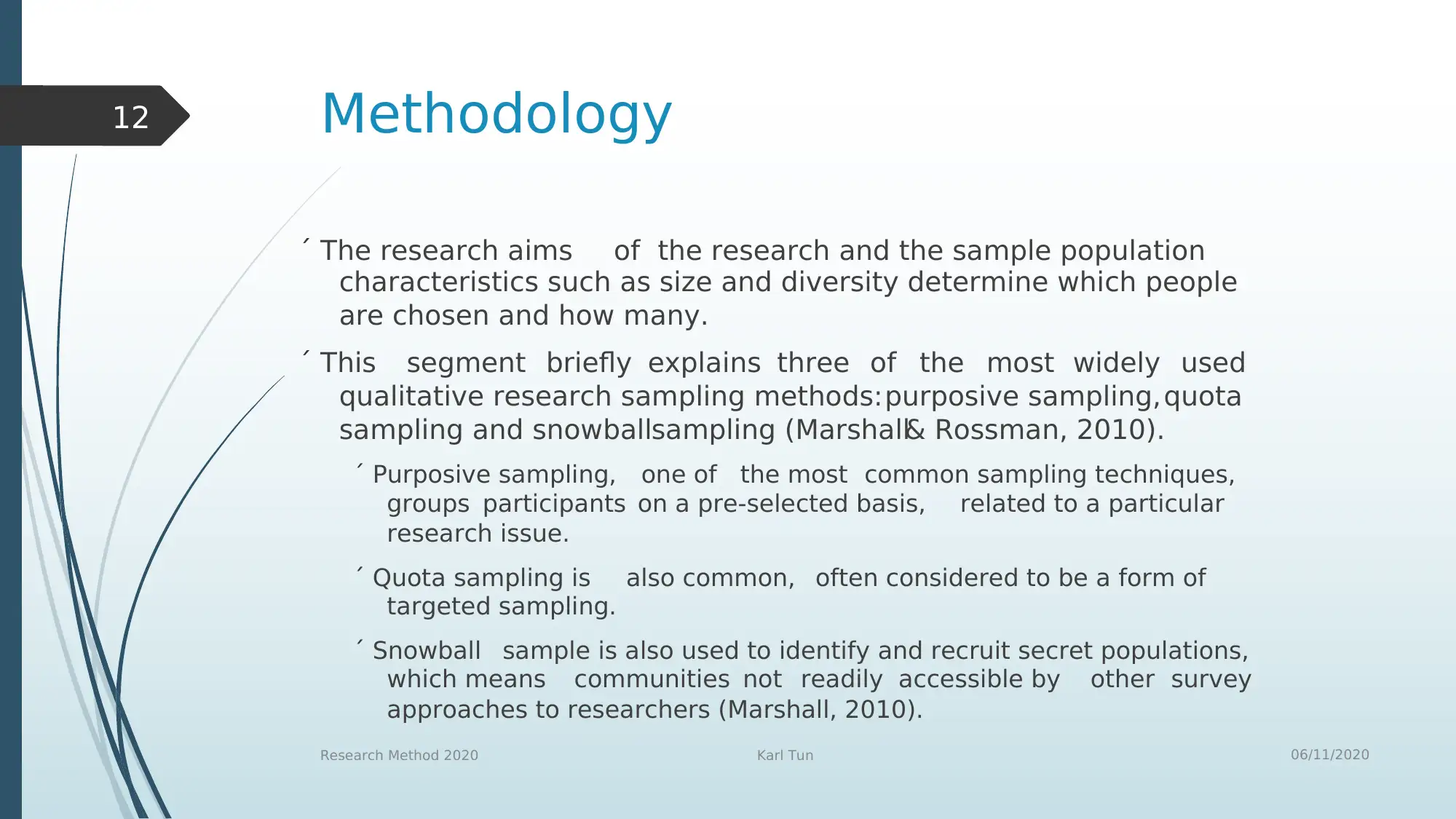
Methodology
´ The research aims of the research and the sample population
characteristics such as size and diversity determine which people
are chosen and how many.
´ This segment briefly explains three of the most widely used
qualitative research sampling methods:purposive sampling,quota
sampling and snowballsampling (Marshall& Rossman, 2010).
´ Purposive sampling, one of the most common sampling techniques,
groups participants on a pre-selected basis, related to a particular
research issue.
´ Quota sampling is also common, often considered to be a form of
targeted sampling.
´ Snowball sample is also used to identify and recruit secret populations,
which means communities not readily accessible by other survey
approaches to researchers (Marshall, 2010).
06/11/2020Research Method 2020 Karl Tun
12
´ The research aims of the research and the sample population
characteristics such as size and diversity determine which people
are chosen and how many.
´ This segment briefly explains three of the most widely used
qualitative research sampling methods:purposive sampling,quota
sampling and snowballsampling (Marshall& Rossman, 2010).
´ Purposive sampling, one of the most common sampling techniques,
groups participants on a pre-selected basis, related to a particular
research issue.
´ Quota sampling is also common, often considered to be a form of
targeted sampling.
´ Snowball sample is also used to identify and recruit secret populations,
which means communities not readily accessible by other survey
approaches to researchers (Marshall, 2010).
06/11/2020Research Method 2020 Karl Tun
12
⊘ This is a preview!⊘
Do you want full access?
Subscribe today to unlock all pages.

Trusted by 1+ million students worldwide
1 out of 17
Related Documents
Your All-in-One AI-Powered Toolkit for Academic Success.
+13062052269
info@desklib.com
Available 24*7 on WhatsApp / Email
![[object Object]](/_next/static/media/star-bottom.7253800d.svg)
Unlock your academic potential
Copyright © 2020–2025 A2Z Services. All Rights Reserved. Developed and managed by ZUCOL.




